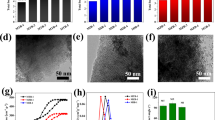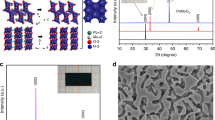Abstract
Capacitive energy storage is distinguished from other types of electrochemical energy storage by short charging times and the ability to deliver significantly more power than batteries. A key limitation to this technology is its low energy density and for this reason there is considerable interest in exploring pseudocapacitive materials where faradaic mechanisms offer increased levels of energy storage. Here we show that the capacitive charge-storage properties of mesoporous films of iso-oriented α-MoO3 are superior to those of either mesoporous amorphous material or non-porous crystalline MoO3. Whereas both crystalline and amorphous mesoporous materials show redox pseudocapacitance, the iso-oriented layered crystalline domains enable lithium ions to be inserted into the van der Waals gaps of the α-MoO3. We propose that this extra contribution arises from an intercalation pseudocapacitance, which occurs on the same timescale as redox pseudocapacitance. The result is increased charge-storage capacity without compromising charge/discharge kinetics in mesoporous crystalline MoO3.
This is a preview of subscription content, access via your institution
Access options
Subscribe to this journal
Receive 12 print issues and online access
$259.00 per year
only $21.58 per issue
Buy this article
- Purchase on Springer Link
- Instant access to full article PDF
Prices may be subject to local taxes which are calculated during checkout




Similar content being viewed by others
References
Tarascon, J. M. & Armand, M. Issues and challenges facing rechargeable lithium batteries. Nature 414, 359–367 (2001).
Whittingham, M. S. Lithium batteries and cathode materials. Chem. Rev. 104, 4271–4301 (2004).
Conway, B. E. Electrochemical Supercapacitors (Kluwer–Academic, 1999).
Winter, M. & Brodd, R. J. What are batteries, fuel cells, and supercapacitors? Chem. Rev. 104, 4245–4269 (2004).
Arico, A. S. et al. Nanostructured materials for advanced energy conversion and storage devices. Nature Mater. 4, 366–377 (2005).
Conway, B. E. Transition from supercapacitor to battery behavior in electrochemical energy storage. J. Electrochem. Soc. 138, 1539–1548 (1991).
Conway, B. E., Birss, V. & Wojtowicz, J. The role and utilization of pseudocapacitance for energy storage by supercapacitors. J. Power Sources 66, 1–14 (1997).
Miller, J. R. & Simon, P. Electrochemical capacitors for energy management. Science 321, 651–652 (2008).
Conway, B. E. 2-dimensional and quasi-2-dimensional isotherms for Li intercalation and UPD processes at surfaces. Electrochim. Acta 38, 1249–1258 (1993).
Jamnik, J. & Maier, J. Nanocrystallinity effects in lithium battery materials—aspects of nano-ionics. Part IV. Phys. Chem. Chem. Phys. 5, 5215–5220 (2003).
Balaya, P. et al. Nano-ionics in the context of lithium batteries. J. Power Sources 159, 171–178 (2006).
Wang, J., Polleux, J., Lim, J. & Dunn, B. Pseudocapacitive contributions to electrochemical energy storage in TiO2 (anatase) nanoparticles. J. Phys. Chem. C 111, 14925–14931 (2007).
Zukalova, M. et al. Pseudocapacitive lithium storage in TiO2(B). Chem. Mater. 17, 1248–1255 (2005).
Li, J. R., Tang, Z. L. & Zhang, Z. T. Pseudocapacitive characteristic of lithium ion storage in hydrogen titanate nanotubes. Chem. Phys. Lett. 418, 506–510 (2006).
Brezesinski, T. et al. Templated nanocrystal-based porous TiO2 films for next-generation electrochemical capacitors. J. Am. Chem. Soc. 131, 1802–1809 (2009).
Brinker, C. J., Lu, Y. F., Sellinger, A. & Fan, H. Y. Evaporation-induced self-assembly: Nanostructures made easy. Adv. Mater. 11, 579–585 (1999).
Richman, E., Brezesinski, T. & Tolbert, S. H. Vertically oriented hexagonal mesoporous films formed through nanometre-scale epitaxy. Nature Mater. 7, 712–717 (2008).
Goltner, C. G. & Antonietti, M. Mesoporous materials by templating of liquid crystalline phases. Adv. Mater. 9, 431–436 (1997).
Zhao, D. Y. et al. Triblock copolymer syntheses of mesoporous silica with periodic 50–300 angstrom pores. Science 279, 548–552 (1998).
Brezesinski, T. et al. Evaporation-induced self-assembly (EISA) at its limit: Ultrathin, crystalline patterns by templating of micellar monolayers. Adv. Mater. 18, 2260–2263 (2006).
Grosso, D. et al. Periodically ordered nanoscale islands and mesoporous films composed of nanocrystalline multimetallic oxides. Nature Mater. 3, 787–792 (2004).
Brezesinski, T. et al. Highly crystalline WO3 thin films with ordered 3D mesoporosity and improved electrochromic performance. Small 2, 1203–1211 (2006).
Tsumura, T. & Inagaki, M. Lithium insertion/extraction reaction on crystalline MoO3 . Solid State Ion. 104, 183–189 (1997).
Li, W. Y., Cheng, F. Y., Tao, Z. L. & Chen, J. Vapor-transportation preparation and reversible lithium intercalation/deintercalation of alpha-MoO3 microrods. J. Phys. Chem. B 110, 119–124 (2006).
Brezesinski, T. et al. Surfactant-mediated generation of iso-oriented dense and mesoporous crystalline metal-oxide layers. Adv. Mater. 18, 1827–1831 (2006).
Warren, B. E. & Averbach, B. L. The effect of cold-work distortion on X-ray patterns. J. Appl. Phys. 21, 595–599 (1950).
Dong, W., Mansour, A. N. & Dunn, B. Structural and electrochemical properties of amorphous and crystalline molybdenum oxide aerogels. Solid State Ion. 144, 31–40 (2001).
Iriyama, Y., Abe, T., Inaba, M. & Ogumi, Z. Transmission electron microscopy (TEM) analysis of two-phase reaction in electrochemical lithium insertion within α-MoO3 . Solid State Ion. 135, 95–100 (2000).
McEvoy, T. M., Stevenson, K. J., Hupp, J. T. & Dang, X. Electrochemical preparation of molybdenum trioxide thin films: Effect of sintering on electrochromic and electroinsertion properties. Langmuir 19, 4316–4326 (2003).
Bard, A. J. & Faulkner, L R. Electrochemical Methods: Fundamentals and Applications (Wiley, 1980).
Li, J. R., Tang, Z. L. & Zhang, Z. T. Layered hydrogen titanate nanowires with novel lithium intercalation properties. Chem. Mater. 17, 5848–5855 (2005).
Kirsch, B. L., Chen, X., Richman, E. K., Gupta, V. & Tolbert, S. H. Probing the effects of nanoscale architecture on the mechanical properties of hexagonal silica/polymer composite thin films. Adv. Funct. Mater. 15, 1319–1327 (2005).
Acknowledgements
The authors thank K.-I. Iimura, A. Reinecke, K. Brezesinski, J. Perlich and V. Augustyn for their assistance in materials preparation and measurements. This work was supported by the Office of Naval Research (B.D. and S.H.T.), the National Science Foundation under grant CHE-0527015 (S.H.T.) and by the Fonds der Chemischen Industrie (Liebig Fellowship, T.B.).
Author information
Authors and Affiliations
Contributions
T.B. and J.W.: experimental work and data analysis. S.H.T. and B.D.: project planning and data analysis.
Corresponding authors
Ethics declarations
Competing interests
The authors declare no competing financial interests.
Supplementary information
Supplementary Information
Supplementary Information (PDF 556 kb)
Rights and permissions
About this article
Cite this article
Brezesinski, T., Wang, J., Tolbert, S. et al. Ordered mesoporous α-MoO3 with iso-oriented nanocrystalline walls for thin-film pseudocapacitors. Nature Mater 9, 146–151 (2010). https://doi.org/10.1038/nmat2612
Received:
Accepted:
Published:
Issue Date:
DOI: https://doi.org/10.1038/nmat2612
This article is cited by
-
Comparing specific capacitance in rice husk-derived activated carbon through phosphoric acid and potassium hydroxide activation order variations
Scientific Reports (2024)
-
Nanocrystalline WSe2 excels at high-performance anode for Na storage via a facile one-pot hydrothermal method
Tungsten (2024)
-
Graphite recycling from spent lithium-ion batteries for fabrication of high-performance aluminum-ion batteries
Rare Metals (2024)
-
FeS quantum dots as an ultrastable host material for potassium-ion intercalation
Journal of Solid State Electrochemistry (2024)
-
Low-temperature-pyrolysis preparation of nanostructured graphite towards rapid potassium storage with high initial Coulombic efficiency
Nano Research (2024)



